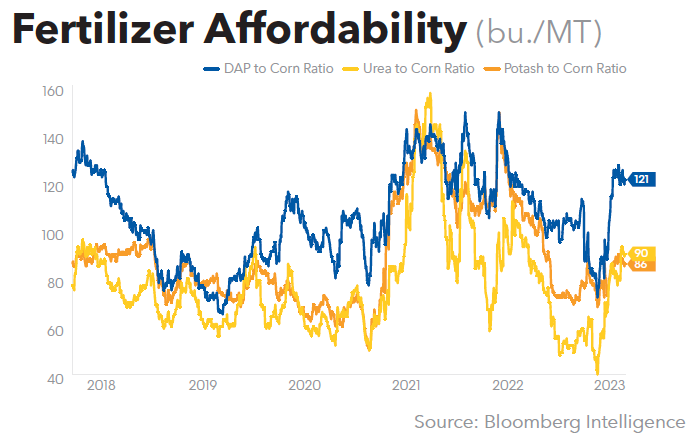
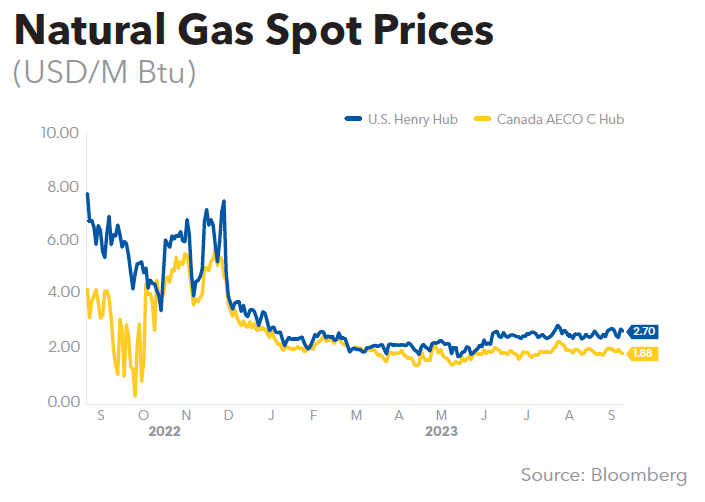
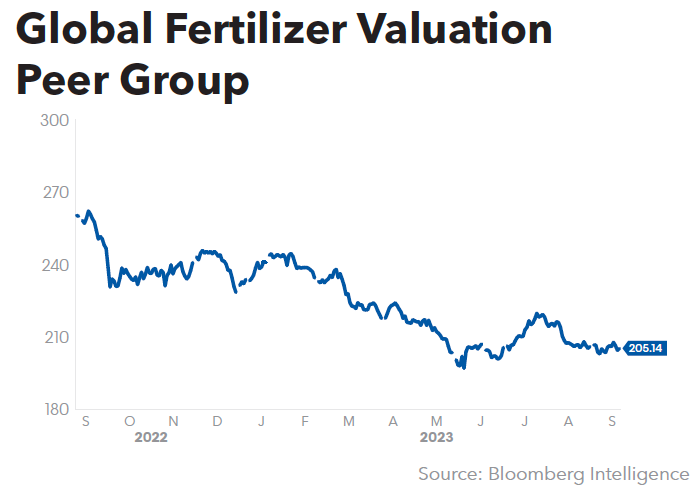
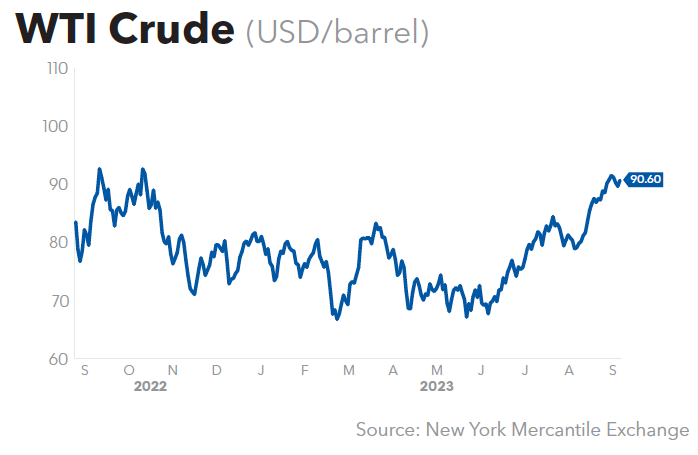
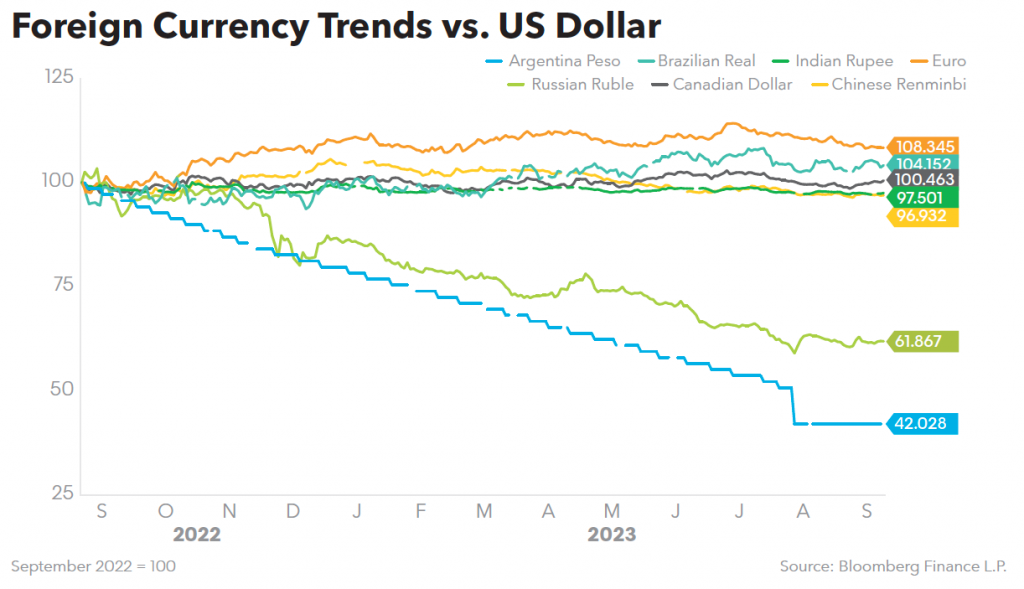
US Gulf:
NOLA potash was reported at the $340-$345/st FOB level for new September-October business, up from last week’s $330-$335/st FOB range.
Eastern Cornbelt:
Potash was unchanged at $385-$400/st FOB in the Eastern Cornbelt, with the high out of inland warehouses and the low reported at Cincinnati and other river terminals.
Western Cornbelt:
Potash remained at $370-$390/st FOB in the Western Cornbelt, with low confirmed at St. Louis. The Caruthersville market was reported at the $385/st FOB level in mid-September.
Southern Plains:
Potash was steady at $380-$390/st FOB Catoosa/Inola and $385/st FOB Houston for the latest business. The last postings from Intrepid FOB Carlsbad, N.M., included $445/st for 60% white granular and $453/st for 62% white standard.
South Central:
Potash was pegged at $380-$390/st FOB in the South Central region in mid-September.
Southeast:
Potash was up slightly at $360-$370/st FOB port terminals in the Southeast, with reports of rail-DEL Canadian tons holding at the $385-$390/st level.
China:
January-August potash imports to China totaled 7.1 million mt, Trade Data Monitor reported, a 28% increase from the year-ago 5.6 million mt. Belarus sent 2.5 million mt, a significant jump from the 1.4 million mt received from Belarus during the first eight months of 2022. August imports were reported at 842,000 mt, up 10% from the 766,000 mt reported for August 2022.
Brazil:
The landed price of potash at Brazil declined to $340-$360/mt CFR, falling $10/mt at the bottom of the range. Players reported wide availability of sanctioned product, while some suppliers are offering product priced on a formula basis.
Potash prices have started to weaken in Rondonopolis. The traded range softened to $485-$495/mt FOB ex-warehouse, off from $485-$500/mt FOB at last report, while offers above $500/mt FOB ex-warehouse failed to transact. In a change from the prior week, sources reported offers for the 2024/25 soybean crop falling below the $500/mt FOB ex-warehouse mark.
Tampa:
Negotiations for the fourth-quarter contract price of molten sulfur delivered to Tampa were rumored to have begun, although no settlements were reported. The third-quarter contract was valued at $55/lt CFR.
US Gulf:
The US Gulf market moved up again, sources noted, to $100-$103/mt FOB from the week-ago $90-$100/mt FOB.
Brazil:
Prices at Brazil lifted to $126-$135/mt CFR, above last week’s $120-$130/mt CFR range. Offers from the Arab Gulf were expected to track closer to the $140/mt CFR level, players said.
Vancouver:
The Vancouver prill price remained steady at $90-$95/mt FOB, unchanged from the prior report.
Alberta:
Alberta netbacks continued at (-)$60-$25/mt FOB, steady from one week earlier. The range included both molten sulfur cargoes contracted into the US market and solid cargoes sold through the Vancouver export market.
West Coast:
Prices for solid sulfur loading from the West Coast remained even with Vancouver at $90-$95/mt FOB.
Molten sulfur contracts for loading in the third quarter were unchanged at $45-$50/lt FOB, off from $98-$106/lt FOB in the prior period.
China:
Import prices at China were steady in the $120-$125/mt CFR range. An accident at a phos rock mine in Hubei province has impacted phosphate fertilizer production in China, according to reports.
ADNOC:
Prilled sulfur produced by the Abu Dhabi National Oil Co. (ADNOC) was posted at $103/mt FOB Ruwais for September loading. Spot prices have been reported firming to $115/mt FOB.
Qatar:
The Muntajat posted sulfur price for September was reported at $102/mt Ras Laffan, up from $82/mt FOB in August.
US Gulf:
US Gulf import sulfuric acid prices were unchanged at $105-$110/mt CFR.
Brazil:
Prices in Brazil firmed to $120-$130/mt CFR, sources said, up from $115-$130/mt CFR at last report. Sulfuric acid values have increased worldwide following a reported 450,000 mt buying spree by OCP. The Moroccan company reportedly took volumes from both Europe and China, lifting prices by about $50/mt FOB at both locations.
Chile:
Reports of sulfuric acid production issues from Noracid have drawn Chilean buyers back to the spot market, sources said, resulting in multiple purchases in the $124-$145/mt CFR range. Annual contract prices at Chile remain unchanged at $142-$148/mt CFR.
The business at Chile came as OCP was also noted picking up large volumes. OCP reportedly remains in the market for November loading.
Eastern Cornbelt:
Heavy rain moved through parts of northern Illinois on Sept. 17, but dry weather dominated the Eastern Cornbelt for the remainder of the week, creating ideal harvest conditions with temperatures reaching the upper-70s and 80s.
The Illinois corn harvest was 6% complete by Sept. 17, compared with 1-2% in Michigan and Indiana, while the soybean harvest was just 1% complete in Illinois, Indiana, and Michigan by that date. Good or excellent ratings were assigned to 54-55% of the corn and soybeans in Illinois and Michigan, 64% in Indiana, and 71-76% in Ohio.
Western Cornbelt:
Central and southwestern Iowa were hit with heavy rain on Sept. 19, with parts of Audubon County registering 6-10 inches of precipitation. Other rainfall totals included 3-4 inches in Ogden and 1-2 inches in Des Moines and Ankeny. Northern Iowa and the Iowa-Missouri border reportedly got little rain from the powerful system.
Nebraska was also bracing for potentially strong storms on Sept. 21-22, with forecasts warning of damaging wind, hail, and locally heavy showers. Rain chances across Missouri were low during the week, with highs reaching the mid-80s by the weekend.
Missouri’s corn harvest was 19% complete by Sept. 17, compared with 5-7% in Iowa and Nebraska, while the soybean harvest had progressed to 3-4% complete in Iowa and Nebraska. Some 47-50% of the corn and beans in Iowa and Nebraska were rated as good or excellent, ahead of Missouri’s 33-43%.
Nebraska growers also had 2% of the sorghum harvested by Sept. 17, with 61% of the acreage rated as good or excellent. Missouri’s rice crop was 27% harvested by that date.
Southern Plains:
Mostly dry weather was reported across central and western Kansas during the week, but scattered thunderstorms were possible on Sept. 21, with highs climbing to the 80s.
Severe storms pushed across the Oklahoma City, Okla., area at midweek, with reports of heavy rain and large hail. Strong storms also brought heavy rain, large hail, and damaging winds to parts of western and northern Texas on Sept. 21.
The regional corn harvest had progressed to 68% complete in Texas and 27% in Kansas by Sept. 17, with good or excellent ratings assigned to 49% of the acreage in Texas, 32% in Kansas, and 54% in Colorado. The Kansas soybean crop was 4% harvested with 23% rated as good or excellent, while the cotton harvest was rated at 20% complete in Texas, with good or excellent ratings assigned to just 10-11% of the acreage in Texas and Oklahoma, compared with 35% in Kansas.
The regional sorghum harvest was also off to a strong start, with 7% of the crop harvested in Kansas and Oklahoma by Sept. 17, compared with 75% in Texas. Fully 83% of Colorado’s sorghum was rated as good or excellent, compared with 45-50% in Texas and Oklahoma and 32% in Kansas.
South Central:
Scattered showers and thunderstorms were popping up in parts of Arkansas, Tennessee, and Kentucky on Sept. 21, though dry conditions dominated for the week. Highs continued to reach the low-80s, with lows dropping to the 50s.
Drought intensified across Louisiana and Mississippi, with extreme-to-exceptional drought covering nearly all of Louisiana and the southern half of Mississippi in mid-September.
The corn harvest was 20-26% complete in Kentucky and Tennessee by Sept. 18, with 72-76% of the acreage rated as good or excellent. The soybean harvest was 66% complete in Louisiana, 42% in Mississippi, 15% in Arkansas, 11% in Tennessee, and 6% in Kentucky by that date, with good or excellent ratings assigned to 75-78% of the acreage in Arkansas and Tennessee, 65-70% in Mississippi and Kentucky, and 42% in Louisiana.
The region’s rice harvest was well advanced at 90-93% complete in Texas and Louisiana, 74% in Mississippi, and 58% in Arkansas. The cotton harvest was 15% complete in Louisiana by Sept. 18, compared with just 1-3% in the rest of the region, with good or excellent rating assigned to 72% of the crop in Tennessee, 65% in Arkansas, and 52-56% in Louisiana and Mississippi.
Southeast:
A tropical storm forming off the Southeast coast brought showers to eastern Florida late in the week, with potentially heavy rain, strong wind gusts, and coastal flooding expected in the Carolinas, Virginia, and Mid-Atlantic region over the weekend.
Growers were harvesting corn, soybeans, cotton, and peanuts in the Southeast in mid-September. North Carolina growers had 65% of the corn and 1% of the soybeans in the bin by Sept. 18, with 68% of the corn and 56% of the soybeans rated as good or excellent.
The cotton harvest was just 1% complete in Alabama and Virginia by that date, with good or excellent ratings assigned to 43% of the acreage in North Carolina, 56-57% in Georgia and South Carolina, 63% in Alabama, and 89% in Virginia.
The peanut harvest was 14% complete in Florida, 7% in Alabama, 4% in South Carolina, and 2-3% in Georgia and Virginia, with good or excellent ratings assigned to 40% of the crop in Alabama, 45% in Florida, 56-57% in Georgia and North Carolina, 85% in South Carolina, and 87% in Virginia.
| 9/15/2023 | Last Week | |
| Memphis | 18.50-19.00 | 18.50-19.00 |
| St. Louis | 20.00 | 20.00 |
| Peoria | 27.00-28.50 | 27.00-28.50 |
| Cincinnati | 30.00 | 30.00 |
| St. Paul | 33.00 | 33.00 |
| Catoosa/Inola | 36.00 | 36.00 |
| 9/8/2023 | Last Week | |
| Memphis | 18.50-19.00 | 18.50-19.00 |
| St. Louis | 20.00 | 20.00 |
| Peoria | 27.00-28.50 | 27.00-28.50 |
| Cincinnati | 30.00 | 30.00 |
| St. Paul | 33.00 | 33.00 |
| Catoosa/Inola | 36.00 | 36.00 |